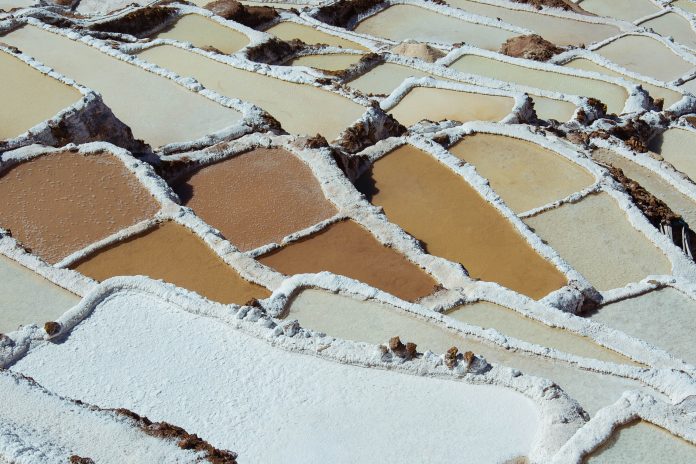Das winzige Dorf Maras zählt noch zu den absoluten Geheimtipps im Süden Perus. Es ist vor allem durch seine spektakulären Salzterrassen bekannt, in denen seit der Zeit der Inka das „Weiße Gold der Anden“ gewonnen wird.
Maras liegt im Heiligen Tal der Inka gleich nach Chinchero an der Verbindungsstraße zwischen Cusco und Urubamba 4 Kilometer westlich der Hauptstraße. Seine zahlreichen Kirchen und mit Wappen verzierte Paläste deuten auf die hohe Bedeutung von Maras zu Perus Kolonialzeit hin. Vor allem berühmt sind jedoch die Salzterrassen von Maras auf einer Seehöhe von 3.300 Metern. Aufgrund derer zählt Maras zu unseren Top 10 Sehenswürdigkeiten von Peru.
Inhaltsverzeichnis
BILDER: Salzterrassen von Maras
Fotogalerie: Salzterrassen von Maras
Vermächtnis der Inka

Gut einen Kilometer nordwestlich von Maras klammern sich an die 3.000 künstlich angelegte terrassenförmige Becken an die steilen Hänge der Cordillera Urubamba. Sie wurden bereits von den Inka zur Salzgewinnung angelegt und zählen heute noch zu einer wichtigen Lebensgrundlage der regionalen Bevölkerung, von der jede Familie zwischen fünf und zehn Becken bewirtschaftet.
Die Salzpfannen werden von Generation zu Generation weitergereicht und es kommt auch vor, dass manche Pools gar nicht betreut werden. Wird ein neues Mitglied oder eine neue Familie in die Gemeinschaft aufgenommen, werden die Pools entsprechend zugewiesen.
Tipp: Über eine 3km lange Wanderung über einen steilen, anstrengenden Pfad gelangt man auch vom Dorf Tarabamba 6 Kilometer vor Urubamba zu den Salzterrassen von Maras.
Das Weiße Gold der Anden

Das Salz, das „Weiße Gold“, wird in den Salinen von Maras auf völlig natürlichem Wege gewonnen. Aus einer salzhaltigen Quelle wird Sole in die nicht einmal 30 Zentimeter tiefen Becken geleitet. Das Wasser verdunstet im Lauf der Zeit durch die Sonneneinstrahlung und das Salz bleibt in schneeweißer, kristalliner Form an den Terrassen zurück.
Anschließend wird das kostbare Gut gesammelt, zu Granulat verarbeitet, in Plastiksäcke verpackt und auf seine 20stündige Reise mit dem LKW nach Lima geschickt, von wo aus es in alle Welt exportiert wird.
Die Arbeit in den Salinen ist hart und erfolgt von vier Uhr in der Früh bis Sonnenuntergang. Menge und Fluss des Wassers müssen von den „Salineros“ ständig überwacht und der Abfluss rechtzeitig geschlossen werden, mögliche Lecks in den Becken müssen gefunden und repariert und die Salzkrusten geerntet werden. Nach drei Tagen wird das Becken mit neuer Sole gefüllt und der gesamte Prozess startet von neuem.
In einem kleinen Souvenir-Shop kann das Weiße Gold der Anden in kleinen Säckchen und Gläsern mit nach Hause genommen werden. Hier geht der Erlös zu hundert Prozent an die Salineros.
Tipp: Im Jahr 2009 entstand unter der Regie von Andrea Oster die knapp einstündige Geo-Reportage „Das Salz der Inka“, die eine Salzbauernfamilie bei der mühsamen Ernte des kostbaren Salzes begleitet.
Inka-Terrassen von Moray
Ebenfalls von Maras aus erreicht man die Inka-Terrassen von Moray. Hier wurde auf den knapp 2 Meter hohen Stufen kein Salz gewonnen, sondern vermutlich landschaftliche Experimente durchgeführt. Aus der ungewöhnlich runden und tiefen Form der Terrassen schlossen die Experten auf ein landschaftliches Forschungszentrum, in dem unterschiedliche ökologische Bedingungen simuliert werden konnten, deren Temperaturunterschiede bis zu 15°C betrugen.
Die Terrassen sind heute allerdings nicht mehr in Verwendung. Mit Hilfe eines Führers gelangt man auch von Moray aus zu den Salzterrassen von Maras.





